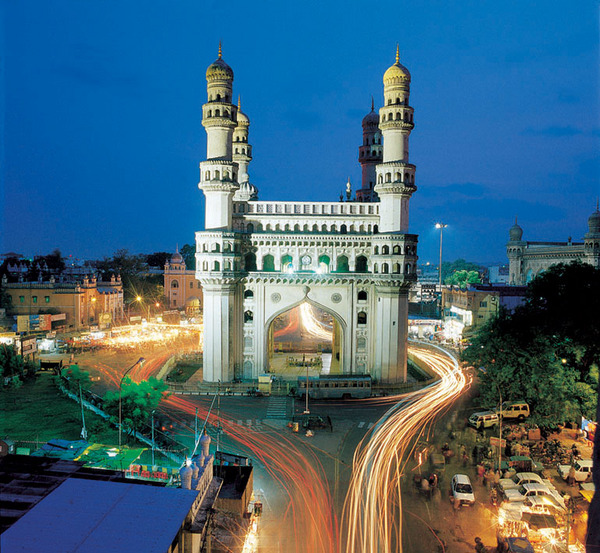Hyderabad, which is almost 500 years old, is the capital city of Andhra Pradesh. It is located on Deccan Plateau. The city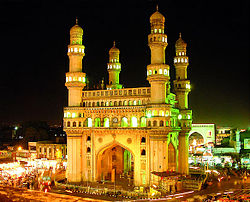 has an average altitude of about 500 metre above the sea level. Most of the regions have rocky terrain.
has an average altitude of about 500 metre above the sea level. Most of the regions have rocky terrain.
Originally, the city of Hyderabad was established on the southern banks of the river Musi. Now, the so-called original Hyderabad city is called as the historical Old City. The Old City is the dwelling to the Charminar and the Mecca Masjid. Many constructions – government buildings and landmarks – are going on in the city center, particularly on the south side of the Husain Sagar Lake. The fast development of the city, along with the development of adjoining city Secunderabad and adjacent municipalities, has resulted in the creation of a huge and densely populated metropolitan region.
With various software firms, call centers, and business process outsourcing (BPO) companies being set up during the early 1990s, Hyderabad has become one of the key areas for such information technology (IT) and IT-enabled service set-ups. Many pharmaceutical companies like Aurobindo Pharma Limited, Divis Labs, Dr Reddy’s Laboratories, Hetero Drugs Limited, Matrix Laboratories, and Vimta Labs are located in the city.
Since Hyderabad has become one of India’s most prominent IT emerging cities as well as the country’s center of scientific and technological development, many people from different parts of the country have migrated there to take advantage of the sprouting opportunities. As a result, the population of Hyderabad has become a potpourri of various ethnic groups. The north Indian states that contribute to the diverse demographic of Hyderabad include Arunachal Pradesh, Chandigarh, Delhi, and Uttar Pradesh. Even the neighboring states such as Maharashtra, Tamil Nadu, and Karnataka have their youths regularly making a beeline to the capital in order to take advantage of the better employment opportunities as well as higher levels of education. The diversity in the population from people coming from different walks, origins and orientation has made Hyderabad a city of diverse cultures that is already cosmopolitan, and this, in turn, spurs the influx of migrating people more.
History
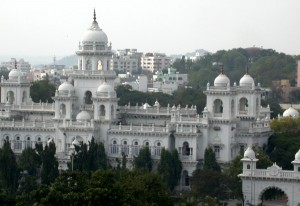 Before the city’s actual historical rise, the area where Hyderabad would ultimately be established was under the rule of several kingdoms, including those of Buddhist and Hindu royalty. It came under rule by the kings of the Chalukya kingdom, whose feudal chieftains, the Kakatiyas, splintered off to create their new kingdom and established it around Warangal. In 1321 AD, the Sultanate of Delhi under the command of Muhammad bin Tughluq brought Warangal to its knees, resulting in anarchy in the whole region. The next few decades saw the battles for supremacy for the region among the Bahmani Sultanate, the Masunuri Nayakas, and the Vijayanagara Rayas, which finally ended with the Bahmani Sultanate exerting control by the middle of the 15th century.
Before the city’s actual historical rise, the area where Hyderabad would ultimately be established was under the rule of several kingdoms, including those of Buddhist and Hindu royalty. It came under rule by the kings of the Chalukya kingdom, whose feudal chieftains, the Kakatiyas, splintered off to create their new kingdom and established it around Warangal. In 1321 AD, the Sultanate of Delhi under the command of Muhammad bin Tughluq brought Warangal to its knees, resulting in anarchy in the whole region. The next few decades saw the battles for supremacy for the region among the Bahmani Sultanate, the Masunuri Nayakas, and the Vijayanagara Rayas, which finally ended with the Bahmani Sultanate exerting control by the middle of the 15th century.
The history of Hyderabad as a city began in 1518 when Sultan Quli Qut-ul-Mulk declared independence from the Bahmani Sultanate and established the fortress city of Golconda, calling himself the Sultan Quli Qutub Shah. Decades before, Sultan Mohammed Shah Bahmani instructed Quli Qut-ul-Mulk to quell insurgents and disturbance in the region, a job which the future ruler carried only too well. By the time he established the Golconda Sultanate under the title of Sultan Quli Qutub Shah and began the Qutub Shahi Dynasty, the Bahmani Sultanate had completely disintegrated, splintering into five different kingdoms.
In 1589, the city of Hyderabad was finally built on the Musi River by the fifth sultan of the dynasty, a mere five miles east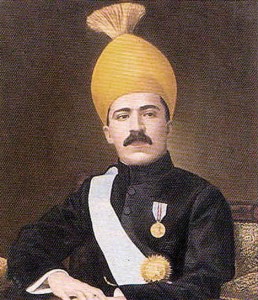 of Golconda. Muhammed Quli Qutub Shah dedicated it to his wife, Bhagyamathi, and also ordered the construction of the monument of the city, which eventually became its icon, the Charminar on 1591, reportedly as a way to thank the almighty for quelling a plague before it destroyed his newly-built city. During this time and well into the 17th century, Hyderabad’s power and fame rose as it became the center of a highly successful diamond trade. All the Qutub sultans, great thinkers and builders as they were, contributed hugely to the richness of Hyderabad’s culture and affluence, attracting countless visitors from other countries who compared it to Iran’s beautiful city, Isfahan.
of Golconda. Muhammed Quli Qutub Shah dedicated it to his wife, Bhagyamathi, and also ordered the construction of the monument of the city, which eventually became its icon, the Charminar on 1591, reportedly as a way to thank the almighty for quelling a plague before it destroyed his newly-built city. During this time and well into the 17th century, Hyderabad’s power and fame rose as it became the center of a highly successful diamond trade. All the Qutub sultans, great thinkers and builders as they were, contributed hugely to the richness of Hyderabad’s culture and affluence, attracting countless visitors from other countries who compared it to Iran’s beautiful city, Isfahan.
Hyderabad’s fame finally caught the attention of the Mughal prince Aurangzeb, who laid siege on Golconda in 1686. Aurangzeb had been spending most of his time in the Deccan establishing and enforcing the Mughal superiority and sovereignity. When Shah Jahan finally died in 1666, Aurangzeb consolidated his power as Emperor and he spent most of it trying to expand his empire beyond that of his predecessor, Akbar the Great. His target was Hyderabad, at that time one of the richest cities in the area, and was reportedly impregnable because of the protection of Golconda ForT.
In 1724, Mir Qamar-ud-Din Siddiqi, was granted the title of Nizam-ul-Muk (meaning Administrator of the Realm) by the Mughal emperor as viceroy tasked to oversee parts of the Mughal empire in behalf of the emperor. He intermittently ruled under the title of Asaf Jah and defeated a rival official in order to establish control over Hyderabad. During this time, viceroys and governors of Hyderabad have gained a considerable autonomy from the seat of power at Delhi and, when the Mughal empire finally crumbled down in the mid 18th century, the young Asaf Jah declared himself independent and the dynasty of the Nizams was established.
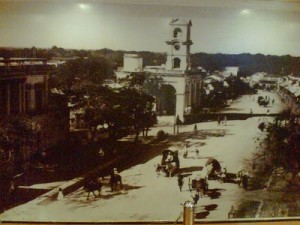 It would not take long before the Nizams quickly surpassed the Mughals in the domination of the southern parts of India, with their dominion hitting as high as 125 million acres (roughly 510,000 square kilometers). It finally became the capital with the old one, Golconda, becoming all but abandoned. Hyderabad’s cultural glory was again established, especially since the Nizams themselves were great patrons of literature, art, architecture, and food. The Nizams themselves were counted as among the wealthiest people in the world; in fact, the last Nizam is ranked as the fifth wealthiest people in the history of the world today, with his fortune at its highest pinned at US$225 billion, adjusted to today’s value.
It would not take long before the Nizams quickly surpassed the Mughals in the domination of the southern parts of India, with their dominion hitting as high as 125 million acres (roughly 510,000 square kilometers). It finally became the capital with the old one, Golconda, becoming all but abandoned. Hyderabad’s cultural glory was again established, especially since the Nizams themselves were great patrons of literature, art, architecture, and food. The Nizams themselves were counted as among the wealthiest people in the world; in fact, the last Nizam is ranked as the fifth wealthiest people in the history of the world today, with his fortune at its highest pinned at US$225 billion, adjusted to today’s value.
When the British and French took hold over most of India, the Nizams played a delicate game of balance and subterfuge. They allied themselves with each side at different times, playing an important role in the wars involving Tipu Sultant, the French, and the British. The Nizams eventually won the friendship of the Western invaders without giving up their powers. As a result, Hyderabad was still ruled by a Nizam, and it became the largest princely state of India. As a princely state, Hyderabad had its own currency, railways, mint, and postal system. The citizens enjoyed no income tax.
When India finally gained its independence in 1947, the Nizam at that time made known his intention to become independent, either by gaining dominion status by the British Empire or as a sovereign ruler. The Nizam signed a Standstill Agreement with the Indian Union which, by this time, had surrounded him on all sides. Breakdown in law and order soon followed, with fights between the supporters of the Nizam and the supporters of Congress. As the violence spiraled out of control, the newly established Indian government initiated a police action called Operation Polo. On September 16, 1948, the Indian army moved in to the state of Hyderabad in five fronts. Five days later, the Nizam’s army surrendered, and the Nizam signed the Instrument of Accession, integrating Hyderabad into the Indian Union as a state.
Places To see
GOLCONDA FORT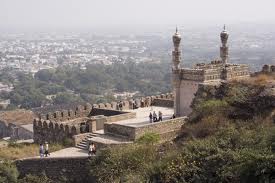
Golconda (sometimes spelled as Golkonda) Fort was the capital of the ancient kingdom of Golconda which flourished in the 14th to 16th century. It is situated 11 kilometers from Hyderabad, the capital of the state of Andhra Pradesh. With walls ranging from 17 to 34 feet broken by 87 semi-circular bastions, some reaching 60 feet in height, and built on a granite hill that is 400 feet high, it remains one of India’s most magnificent fortress complexes.
CHARMINAR
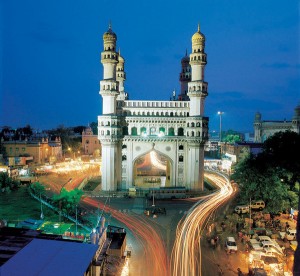 No visit to Hyderabad should be undertaken without visiting the grand and majestic centerpiece of the city that is Charminar. Translated roughly as “Four Towers” or “Mosque of the Four Minarets”, the Charminar is also called by some as the Arc de Triomphe of the East and is one of the most important monuments of Hyderabad.
No visit to Hyderabad should be undertaken without visiting the grand and majestic centerpiece of the city that is Charminar. Translated roughly as “Four Towers” or “Mosque of the Four Minarets”, the Charminar is also called by some as the Arc de Triomphe of the East and is one of the most important monuments of Hyderabad.
QUTUB SHAHI TOMBS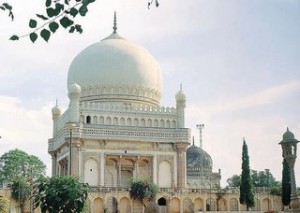
Located about a kilometer north from Golconda Fort, the Qutub Shahi tombs represent the most authentic and majestic display of the Qutub Shahi dynasty architectural traditions today. The grandeur of the tombs is ensconced amidst the beautiful and picturesque landscape and gardens of Ibrahim Bagh, and the tombs themselves are dedicated to the seven Qutub Shahi kings who ruled Golconda for nearly 170 years.
YADAGIRIGUTTA TEMPLE
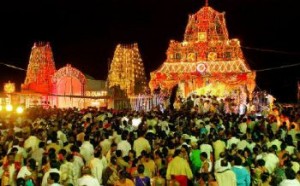 Legend has it that a sage named Yadavarishi, the son of the great sage Rishyasrunga, did penance and meditation in a cave and asked for the blessings of Lord Narasimha, an incarnation of the Hindu deity Lord Vishnu. So pleased was Lord Narasimha to Yadavarishi that he appeared to him in five different forms: Jwala, Yogananda, Lakshminarasimha, Gandabherunda, and Ugra. The legend goes that the first form was too intense and fiery (it was Lord Narasimha as a fire) that it was too much for the yogi, so Narasimha adopted the second, more peaceful, form (Lord Narasimha in a Yoga posture with open palms on the knees). This still didn’t satisfy the yogi though and wanted to see him with his counterpart, the goddess Lakshmi, so Narasimha appeared with the goddess on his lap. The place where all this was supposed to have taken place was a natural cavern atop a hill. The temple was then built in the same area.
Legend has it that a sage named Yadavarishi, the son of the great sage Rishyasrunga, did penance and meditation in a cave and asked for the blessings of Lord Narasimha, an incarnation of the Hindu deity Lord Vishnu. So pleased was Lord Narasimha to Yadavarishi that he appeared to him in five different forms: Jwala, Yogananda, Lakshminarasimha, Gandabherunda, and Ugra. The legend goes that the first form was too intense and fiery (it was Lord Narasimha as a fire) that it was too much for the yogi, so Narasimha adopted the second, more peaceful, form (Lord Narasimha in a Yoga posture with open palms on the knees). This still didn’t satisfy the yogi though and wanted to see him with his counterpart, the goddess Lakshmi, so Narasimha appeared with the goddess on his lap. The place where all this was supposed to have taken place was a natural cavern atop a hill. The temple was then built in the same area.
RAMOJI FILM CITY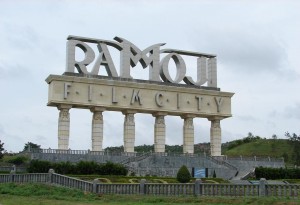
If the United States has Universal Studios, then India has Ramoji Film City, the world’s largest integrated film studio complex. Spread over 2,000 acres of land studded with hills and lakes, it is India’s filmmakers’ first choice when it comes to making their films as it is essentially an unlimited area of creativity for any major or minor film production. Every facility a filmmaker could ever want can already be found there: 50 studio floors, support systems, high-tech laboratories, outdoor locations, up-to-date technology, greenery, and the wonderful hillscapes.
PAIGAH TOMBS
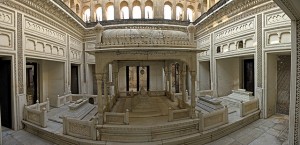 One of the more influential and powerful families of the Hyderabad State aristocracy during the 18th century are the noble families of Paigah. Claiming to have descended from Hazrath Omar bin Al-Khattab, the second caliph of Islam, the Paigah nobles tend to be richer than the average Indian Maharajah and they alone hold exclusive rights to maintain their own court, their own palaces, and their own private armies that often numbered to the thousands. The word Paigah is Farsi for “footstool” of which an English equivalent would be “right-hand man”.
One of the more influential and powerful families of the Hyderabad State aristocracy during the 18th century are the noble families of Paigah. Claiming to have descended from Hazrath Omar bin Al-Khattab, the second caliph of Islam, the Paigah nobles tend to be richer than the average Indian Maharajah and they alone hold exclusive rights to maintain their own court, their own palaces, and their own private armies that often numbered to the thousands. The word Paigah is Farsi for “footstool” of which an English equivalent would be “right-hand man”.
HITEC CITY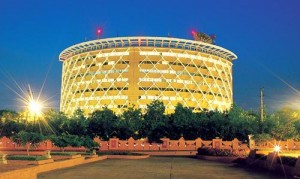
At the heart of Hyderabad’s technological progress juggernaut is the cybercity called HITEC City. The name stands for Hyderabad Information Technology Engineering Consultancy City and it provides a stark contrast to the historically-laden monuments and sites present in Hyderabad. The formation and birth of the HITEC City is the consummation of a state’s vision of becoming a contender in the information technology boom, largely reminiscent of Muhammad Quli Qutub Shah’s dreams when he started building Hyderabad itself.
DHOLA-RI-DHANI
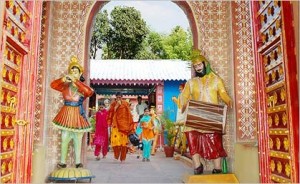 In the case of Dhola-Ri-Dhani, the experience offered is that of a genuine ethnic Rajasthani culture, with a dash of fantasy. Located in Kompally, in the Medchal highway in Hyderabad (and about 11 kilometers from Secunderabad), the place offers tourists and visitors the chance to see an amalgamation of two cultures. Its design and style allows the visitors to experience the culture of Rajasthan without having to leave Hyderabad. .
In the case of Dhola-Ri-Dhani, the experience offered is that of a genuine ethnic Rajasthani culture, with a dash of fantasy. Located in Kompally, in the Medchal highway in Hyderabad (and about 11 kilometers from Secunderabad), the place offers tourists and visitors the chance to see an amalgamation of two cultures. Its design and style allows the visitors to experience the culture of Rajasthan without having to leave Hyderabad. .
MIR ALAM TANK
the Mir Alam Tank has contributed incessantly to the city for the past 200-odd years since it was built; it has provided drinking water to the people of Hyderabad for 125 years before both Osman Sagar and Himayat Sagar reservoirs were finally built. During that time, waters coming from Mir Alam Tank were said to be so sweet and pure that people who have tasted it were said to have carried containers of it whenever they went out of Hyderabad.
How To Reach
By Air
Hyderabad International Airport, Rajiv Gandhi International Terminal, is well connected to many important cities abroad. Domestic terminal, N T Rama Rao domestic Terminal, connects to all major cities in India. All private air travel providers operate services from Hyderabad. The both airport are located side by side and are located at Begumpet, about 20 km away from the heart of the city. Taxi services cost about Rs 350 from Airport to Hyderabad city.
By Train
Secunderabad, one of the twin cities with Hyderabad, is a major station with the head quarters of Southern Railway. Nampally railway station is well connected to all major railway stations in India.
By Bus
Andra Pradesh state owned buses connect Hyderabad city with all cities in the state and the neighboring states. Hyderabad is a hub of deluxe, super deluxe, A/C and Volvo tourist buses. Hyderabad is connected by these superb buses to many cities, including Bangalore, Chennai, Vishakapatnam and Vijayawada.
Fact File
State: Andhra Pradesh
Population 4025335
Famous for/as: Heritage
Languages: Telugu, English
Best Season: Oct – Mar
Weather: Summer 30-40°C, Winter 14-22°C
Altitude: 536 m
Pincode: 500xxx
Area 650 sq kms
STD Code 040
Latitude 17.3667° N
Longitude 78.4667° E
Submit your review | |
